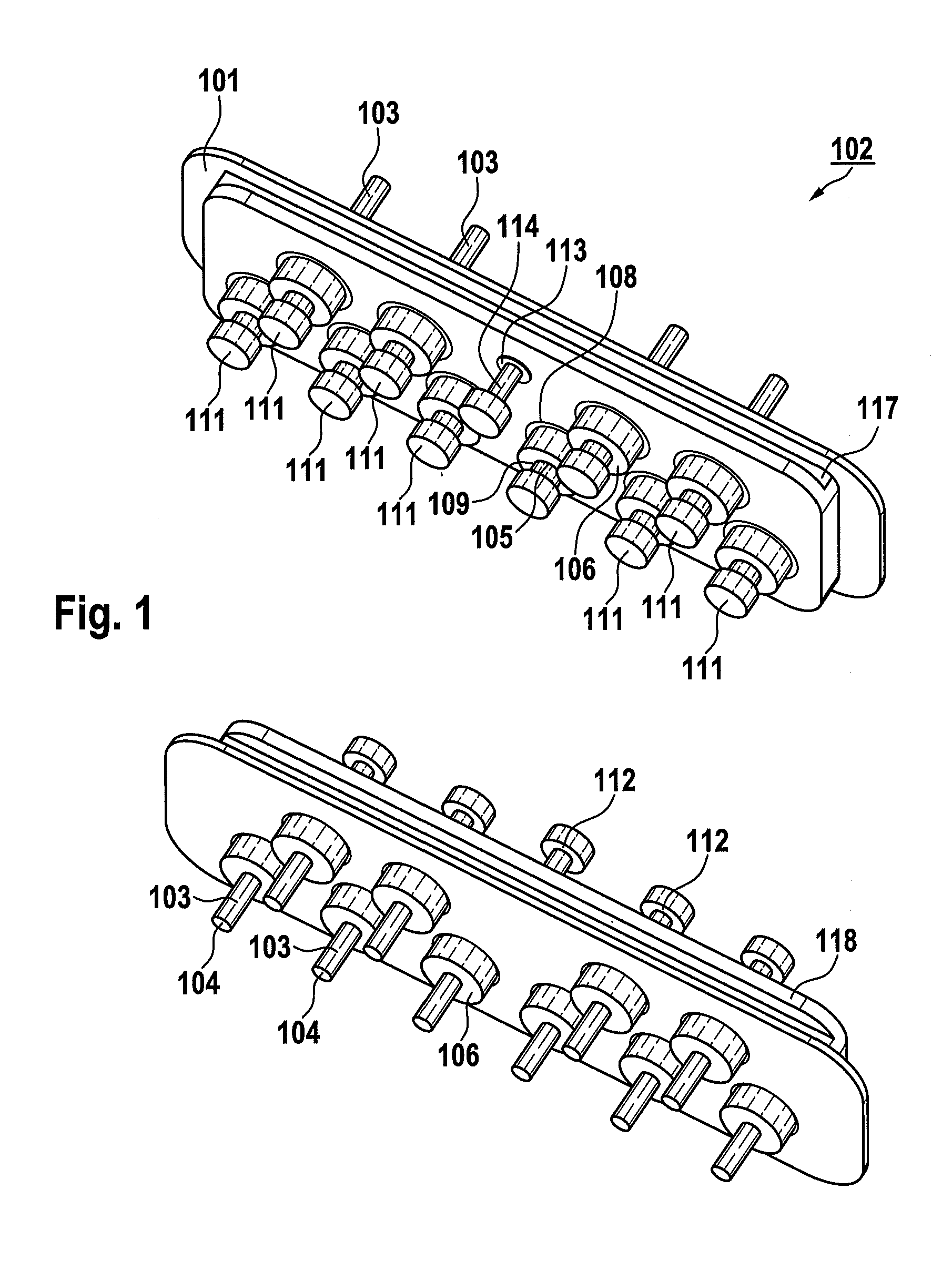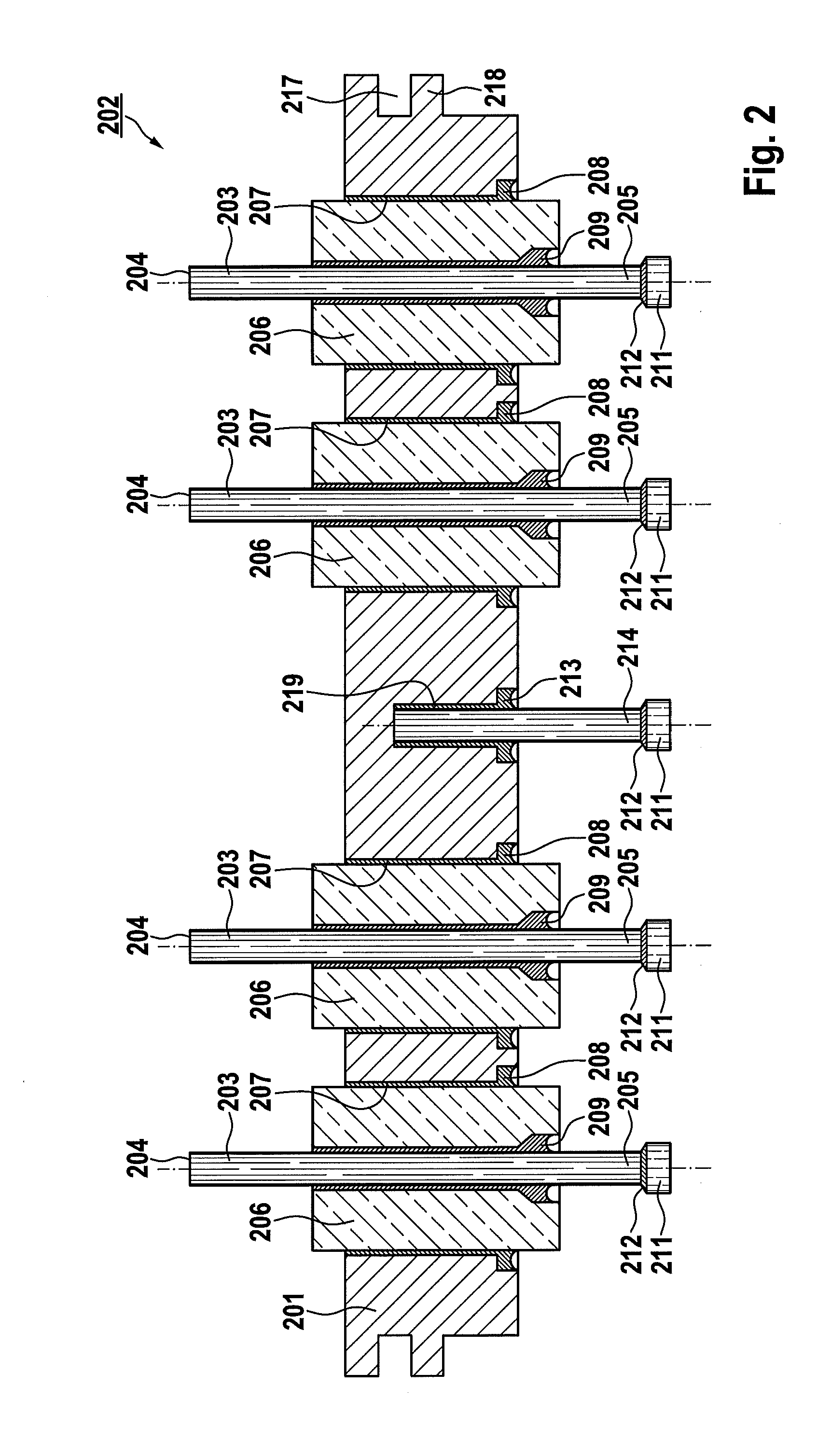[0009]The present invention is based on the object of disclosing a hermetically sealed feedthrough for terminal electrodes made of a body-compatible material toward the implant outer side, which is contact-connectible in a manner having simple production on their inner end to the electronics situated there, in particular using
reflow soldering.
[0011]The section of the terminal pin which can be joined at a lower energy and can preferably be soft soldered provides the
advantage that the terminal pin can be joined in the interior of the implant securely and easily using lower energy—for example, lower
heat energy up to 450° C., which is used above all in soft
soldering processes. In particular, in a reflow process, cost-effective soft soldering can be produced simultaneously with other components on the
electronic circuit board of the implant. These sections of the terminal pins may be installed together with the other components of the electrical feedthrough in the form of the at least one feedthrough
bushing simultaneously in a common high-temperature
soldering process, which in turn represents a particularly cost-effective mode of attachment. Furthermore, the formation of brittle phases between the section of the terminal pin and the soft solder used is avoided by use of the section of the terminal pin which can be joined at a lower energy in the interior of the implant, as otherwise formed, for example, between gold electrodes and soft solders having
tin components.
[0012]Optionally, the sections of the terminal pin which can be joined at a lower energy may additionally also be provided with coatings which can be soft soldered particularly well, i.e., are easily wettable, having materials such as
palladium (Pd), silver (Ag),
copper (Cu), gold (Au), and alloys made of these materials, the
coating having a
layer thickness up to approximately 0.5 mm and a thickness up to approximately 200 μm in the case of a gold coating. A gold coating having this
layer thickness is known not to form brittle phases together with soft soldering materials containing
tin components.
[0014]The section made of the above listed materials, or other similar materials, which can be joined at a lower energy can be an attachment which is located on the inner end of the terminal pin. This attachment can be implemented as a pin, on the one hand, which is advantageously located in an extension of the longitudinal axis of the terminal pin and allows the ready
accommodation of further components such as filters to ensure the
electromagnetic compatibility (EMC filters) in the form of capacitors because of the lack of thickened areas. Alternatively, the attachment can also be implemented as a disk or round blank, which offers larger areas to the corresponding contact points on the partner circuit board as an
advantage during the reflow process and allows mechanically stronger connections having higher carrying capacities.
[0015]The attachment which can be joined at a lower energy is preferably attached using a joint to the biocompatible section of the terminal pin, in particular hard solder alloys containing, for example,
copper (Cu), silver (Ag),
copper-
nickel (CuNi), copper-
zinc (CuZn), copper-
tin (CuSn), silver-copper (AgCu), silver-copper-
zinc (AgCuZn), silver-copper-
zinc-tin (AgCuZnSn), silver-copper-tin (AgCuSn), silver-copper-zinc-
cadmium (AgCuZnCd), copper-
phosphorus (CuP), copper-
phosphorus-silver (CuPAg), or copper-gold (CuAu), using which temperature inhomogeneities during the
brazing process may be compensated for.
Brazing using gold solder / gold solder alloys is preferred. Further, alloys thereof having additional possible
alloy additives such as Pb, Sb, As, Bi, P, N, Be, Ni are also possible. Furthermore, the attachment which can be joined at a lower energy can be soldered, welded, crimped, clamped, or glued in an
electrically conductive manner on the biocompatible section of the terminal pin using a joint, but is preferably brazed using gold solder. Preferably, the joint between the biocompatible section and the attachment which can be joined at a lower energy is located inside the implant housing in relation to the connection solder. This is the preferred type of attachment, because it is simple, reliable because of a lack of brittle phases, has mechanical
carrying capacity, and can be implemented simultaneously together with the further feedthrough components in the same
soldering process of the feedthrough. Because this attachment occurs already before the attachment to the electrical circuit in the interior of the implant, a welding or
brazing procedure can be performed therein at the joint. In a preferred embodiment, the joint can be located within the at least one feedthrough bushing. It may thus be implemented easily in the
soldering process of the feedthrough because of the centering action of the feedthrough bushing and may additionally protect it from mechanical strains and further influences. Furthermore, it is particularly preferably possible to also enclose it in the glass solder. This results in more extensive protection from mechanical strains, because the joint and the adjoining pin areas are mechanically decoupled toward the exterior by the glass solder.
 Login to View More
Login to View More  Login to View More
Login to View More 


